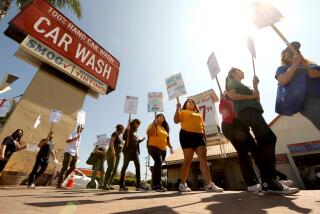Capitol Journal: U.S. budget ax hangs over California
- Share via
From Sacramento — It’s a seldom discussed fact how heavily dependent Sacramento is on Washington’s borrowed money.
The same goes for California schools and local governments.
They’re all huge targets as Congress takes aim at federal debt.
It’s unlikely the Obama administration would have defaulted on U.S. Treasury bonds even if Congress had remained gridlocked on debt ceiling legislation. Stiffing bondholders would have irreparably tarnished the nation’s image abroad. Instead, Washington would have slammed it to the states and federal contractors.
That’s the sort of thing Sacramento habitually has done after failing to pass a budget on time. It has stuck it to local governments, schools, nursing homes, vendors — almost anyone except bondholders.
There’s a lot of federal money for Washington to retrieve in state capitols, especially California’s.
The dirty little secret is that California’s current state budget is not $85.9 billion, the size of the much-debated, deficit-plagued general fund. You’ve got to add in the special funds ($34.2 billion) — much of them fed by fees dedicated for specific purposes — plus bond money ($9.4 billion). That totals $129.5 billion, but it still ignores federal dollars.
The real state budget includes an additional $79.2 billion in federal largesse, representing 38% of total state spending. This brings the grand total to $208.7 billion.
So the state of California is getting a nearly $209-billion spending program while putting up less than $130 billion itself.
“It’s extremely significant,” notes state Assembly Budget Committee Chairman Bob Blumenfield (D-Woodland Hills). “If it were not for federal spending and the stimulus package, the recession in California would have been dramatically worse. The impact on schools and state services would have been devastating.”
Most of the federal funds come with strict rules attached. Much of it is what’s known in government lingo as “pass through” money — it’s automatically passed on by Sacramento to local entities. The state does take a 2.5% administrative fee.
There’s little opportunity for games-playing — and much less than there used to be — although Capitol politicians try their best.
“They’ve done plenty of very creative things to get the benefit out of federal money, like with the stimulus funds,” says Mike Genest, state finance director for former Gov. Arnold Schwarzenegger. “Sometimes the federal government has rules that can be exploited and they don’t mind…
“In the ‘80s and ‘90s, we were among the most creative states in making federal costs go up.”
Where does the federal money go? You have to dig deep into state budget documents, looking hard at the fine print, to find out.
Currently, nearly $41 billion is spent on health and human services. Of that, about $29 billion —almost twice what the state puts up — goes for Medi-Cal, California’s version of Medicaid healthcare for the poor.
Medicaid is exempt from initial federal spending cuts. But who knows what might be on the chopping block if Congress really gets serious about controlling spending.
Another $3.2 billion in federal money goes to the state CalWorks welfare program. That’s $1.1 billion more than Sacramento kicks in.
The state Employment Development Department takes in $19.7 billion from Washington, practically all of it for unemployment insurance benefits.
The Department of Education receives $6.9 billion for K-12. Of that, $2.2 billion pays for poor kids’ lunches, $1.7 billion provides other services for low-income students and $1.2 billion helps fund special education. There’s also $700 million for child care and after-school programs. And there’s money to lend to new charter schools.
The University of California pulls in $3.5 billion and the state universities $1 billion, mostly in research grants.
Caltrans rakes in about $4.3 billion from Washington, much of it for highway construction. The feds generally pay 88% of an interstate project.
The state Emergency Management Agency gets nearly $1.1 billion. Virtually all of it is shuffled out to local entities for disaster aid, homeland security, hazard mitigation, public safety and victim services.
All programs are in jeopardy. It’s a good bet much of their federal funding will be trimmed or terminated in the future.
And it’s not like Sacramento already hasn’t been whacking away. This year’s general fund is down roughly 6% from $91.5 billion last year. It’s about 17% lower than three years ago.
Genest, a longtime numbers cruncher for Republican politicians, says that future federal cuts would have a huge impact on state services, and he adds: “Personally, I say so what?
“We’re going to have to cut these services. It’s not that we can afford everything that people want. I’m a ‘tea party’ guy. I think they should have cut a lot more than they did. We’re spending a lot more than is coming in, and that’s got to stop.”
On the other side, state Senate Budget Committee Chairman Mark Leno (D-San Francisco) says: “My greatest concern is that [the cutting] may have a recessionary impact on the overall economy and cause more damage. The result could be double-digit unemployment in California for years.
“Many economists look back at 1937 when the Great Depression had a second dip and Congress did just what it’s doing now. It retrenched on government spending.”
It took Nazi Germany and Imperial Japan to end America’s depression by forcing us into war.
Unlike former President George W. Bush, however, FDR did not cut taxes for the wealthy while financing a war. But that’s for another day.
What Californians — all Americans — need is an honest debate over which services we want to pay for and how do we go about it. And the answer is not mindless borrowing.
More to Read
Sign up for Essential California
The most important California stories and recommendations in your inbox every morning.
You may occasionally receive promotional content from the Los Angeles Times.










